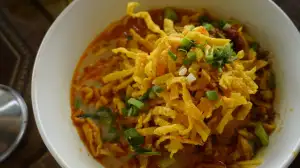Passover Dinner Delights: Celebrate the Jewish Holiday with Our Mouthwatering Recipes

- Significance of Passover in Jewish Tradition
- Traditional Passover Foods
- Matzo: The Unleavened Bread
- Charoset: A Symbolic Fruit and Nut Mixture
- Gefilte Fish: A Classic Passover Appetizer
- Matzo Ball Soup: A Nourishing Start to the Meal
- Brisket: The Heartwarming Main Course
- Tzimmes: A Sweet and Savory Side Dish
- Kugel: A Delicious Casserole for Passover
- Passover Desserts: Flourless Delights
Passover, also known as Pesach, is a significant holiday in the Jewish tradition. It commemorates the liberation of the Israelites from slavery in ancient Egypt. One of the central aspects of Passover is the Passover dinner, which brings families and friends together to celebrate and remember this important event. The Passover dinner is a time for reflection, gratitude, and joy as participants gather around the table to partake in a delicious feast filled with traditional foods. In this article, we will explore some mouthwatering recipes that will help you create a memorable Passover dinner for your loved ones. From matzo to brisket to flourless desserts, get ready to embark on a culinary journey that celebrates both tradition and taste.
Significance of Passover in Jewish Tradition
Passover holds immense significance in Jewish tradition. It commemorates the liberation of the Israelites from slavery in ancient Egypt. The holiday is a time for reflection, gratitude, and remembrance of the hardships endured by our ancestors. It symbolizes freedom and redemption, reminding us of the power of faith and perseverance. Passover is a time for family gatherings, storytelling, and passing down traditions from one generation to another. The dinner table becomes a sacred space where we honor our history and celebrate our identity as a people.
Traditional Passover Foods
Passover is a Jewish holiday that is celebrated with a special dinner filled with traditional foods. These dishes have deep significance in Jewish tradition and are an essential part of the Passover experience. Each dish tells a story and carries symbolic meaning, making the meal even more meaningful and memorable. From the unleavened bread to the flavorful charoset, these traditional Passover foods are sure to delight your taste buds and transport you to the heart of this ancient celebration.
Matzo: The Unleavened Bread
Matzo, also known as matzah, is a central element of the Passover dinner. This unleavened bread holds great significance in the Jewish tradition, representing the haste in which the Israelites left Egypt. During their escape, they did not have time to wait for bread to rise, so they baked unleavened dough instead.
Matzo is made from simple ingredients: flour and water. The dough is rolled out thinly and then baked quickly at high temperatures to prevent it from rising. The result is a crisp and cracker-like bread that is eaten throughout the Passover holiday.
The plain matzo serves as a reminder of the hardships endured by the Jewish people during their exodus from Egypt. It symbolizes humility and simplicity, encouraging reflection on freedom and gratitude.
In addition to plain matzo, there are various types of flavored matzo available today. These include whole wheat, spelt, and even chocolate-covered varieties. However, during Passover dinner, it is customary to eat traditional plain matzo as a reminder of our ancestors' journey to freedom.
Whether enjoyed on its own or used as a base for other Passover dishes, matzo adds an essential element to the Passover dinner table. Its unique texture and flavor make it a delicious accompaniment to charoset, gefilte fish, and many other traditional dishes served during this special holiday meal.
Charoset: A Symbolic Fruit and Nut Mixture
Charoset is a symbolic fruit and nut mixture that holds a special place in the Passover dinner. It represents the mortar used by the Jewish slaves in Egypt when building structures for their captors. The ingredients vary depending on cultural traditions, but commonly include chopped apples, nuts, honey, cinnamon, and sweet wine. The mixture is often served on matzo or eaten as a standalone dish. Its sweet and crunchy texture adds a delightful contrast to the other flavors of the Passover meal. Charoset serves as a reminder of the hardships endured by the Jewish people in ancient times and symbolizes their liberation from slavery.
Gefilte Fish: A Classic Passover Appetizer
Gefilte fish is a beloved and classic Passover appetizer that holds a special place in Jewish cuisine. Traditionally made by grinding whitefish, pike, or carp with onions, eggs, and matzo meal, gefilte fish is then formed into small oval-shaped patties and poached in a flavorful fish stock. The result is a delicate and savory dish that is often served chilled with horseradish on the side. While store-bought versions are readily available, many families take pride in making their own homemade gefilte fish, passing down cherished recipes from generation to generation. This appetizer not only adds a touch of tradition to the Passover table but also serves as a delicious start to the festive meal.
Matzo Ball Soup: A Nourishing Start to the Meal
Matzo Ball Soup is a classic dish that holds a special place in Passover dinners. This nourishing soup consists of matzo balls, which are made from matzo meal, eggs, and oil. The matzo balls are light and fluffy, providing a comforting texture in every spoonful.
The soup itself is usually a clear chicken broth, although vegetable-based versions are also popular. It is seasoned with herbs and spices to enhance the flavor. The combination of the savory broth and delicate matzo balls creates a harmonious balance that warms the soul.
Serving Matzo Ball Soup at the beginning of the Passover meal not only satisfies hunger but also symbolizes the unleavened bread eaten during this holiday. As we savor each spoonful, we are reminded of the hardships faced by our ancestors during their journey out of Egypt.
This simple yet satisfying soup sets the tone for the rest of the Passover dinner, preparing our taste buds for the delicious dishes that lie ahead. So gather around the table with loved ones and enjoy this nourishing start to your Passover celebration.
Brisket: The Heartwarming Main Course
One of the highlights of a Passover dinner is undoubtedly the brisket. This slow-cooked, tender cut of beef is a true crowd-pleaser and always steals the show as the main course.
To prepare this heartwarming dish, start by seasoning the brisket with a blend of aromatic spices such as garlic powder, paprika, and black pepper. Then, sear it on all sides to lock in the flavors. Next, place the brisket in a roasting pan along with onions, carrots, and potatoes. Pour in some beef broth and cover tightly with foil.
Allow the brisket to cook low and slow in the oven for several hours until it becomes melt-in-your-mouth tender. The aroma that fills your kitchen will make everyone's mouths water in anticipation.
When it's time to serve, slice the brisket against the grain to ensure maximum tenderness. Spoon some of those delicious pan juices over each serving for an extra burst of flavor.
The rich flavors of the brisket combined with its succulent texture make it a perfect centerpiece for your Passover dinner. It pairs beautifully with traditional sides like roasted vegetables or potato kugel.
So this Passover, gather your loved ones around the table and delight them with this heartwarming main course. The brisket will not only satisfy their appetites but also fill their hearts with warmth and joy as you celebrate this meaningful holiday together.
Tzimmes: A Sweet and Savory Side Dish
Tzimmes is a traditional sweet and savory side dish that adds a burst of flavor to the Passover dinner table. Made with carrots, sweet potatoes, and dried fruits such as prunes or raisins, tzimmes is slow-cooked in a honey and cinnamon glaze until tender and caramelized. The combination of the naturally sweet vegetables and the rich sweetness of the honey creates a delightful balance of flavors. Tzimmes is not only delicious but also symbolic, representing the hope for a sweet and prosperous year ahead. This versatile dish can be served hot or cold, making it a perfect addition to any Passover meal.
Kugel: A Delicious Casserole for Passover
Kugel is a beloved dish that is often served during Passover dinner. This delicious casserole is made with noodles, eggs, and a variety of ingredients such as apples, raisins, and cinnamon. The mixture is then baked until golden brown and crispy on the outside, while remaining soft and creamy on the inside. Kugel is a versatile dish that can be served as a side or even as a dessert. Its sweet and savory flavors make it the perfect addition to any Passover meal. Whether you prefer a traditional recipe or want to try something new, kugel is sure to delight your taste buds and add an extra layer of deliciousness to your Passover dinner.
Passover Desserts: Flourless Delights
No Passover dinner is complete without a selection of delicious desserts to end the meal on a sweet note. Since leavened products are not allowed during this holiday, flourless desserts become the star of the show. These treats are not only tasty but also adhere to the dietary restrictions of Passover.
One popular flourless dessert is the Passover chocolate cake. Made with ground almonds and rich cocoa powder, this cake is moist, decadent, and perfect for chocolate lovers. It's often topped with a dusting of powdered sugar or a drizzle of chocolate ganache for an extra touch of indulgence.
Another beloved Passover dessert is macaroons. These delightful cookies are made from shredded coconut, egg whites, and sugar. They come in various flavors such as almond, chocolate, and even raspberry. Crispy on the outside and chewy on the inside, macaroons are a crowd-pleaser that everyone can enjoy.
For those who prefer something fruity and refreshing, Passover fruit compote is an excellent choice. This dessert combines a medley of dried fruits like apricots, prunes, and raisins with sweet wine and warm spices like cinnamon and cloves. The result is a fragrant and comforting dish that pairs well with a dollop of whipped cream or vanilla ice cream.
Lastly, let's not forget about matzo bark—a simple yet addictive treat that combines matzo crackers with melted chocolate and various toppings like nuts or dried fruit. The combination of crunchy matzo with smooth chocolate creates a delightful texture contrast that will have you reaching for seconds.
These flourless delights prove that Passover desserts can be just as delicious as their leavened counterparts. So go ahead and indulge in these sweet treats while celebrating this joyous holiday with your loved ones!
As the Passover dinner comes to an end, we are left with a sense of fulfillment and joy. The delicious aromas, the symbolic foods, and the gathering of loved ones create an atmosphere of warmth and togetherness. By preparing traditional Passover dishes like matzo ball soup, brisket, and charoset, we not only honor our ancestors but also pass down our rich cultural heritage to future generations.
The significance of Passover goes beyond just a meal; it is a time for reflection, gratitude, and celebration. As we gather around the table, we remember the hardships our ancestors endured and their journey to freedom. We appreciate the blessings in our lives and express gratitude for the abundance on our plates.
By incorporating these mouthwatering recipes into our Passover dinner, we infuse each dish with love and tradition. From the unleavened bread to the flavorful tzimmes and kugel, every bite is a reminder of our shared history and resilience as a community.
So this Passover, let us come together to craft delicious memories with our food recipes. Let us celebrate this special holiday by savoring each dish with gratitude and joy. May this memorable dinner be filled with laughter, love, and homemade happiness that will last long after the last crumb has been enjoyed.
Published: 05. 12. 2023
Category: Food



